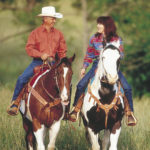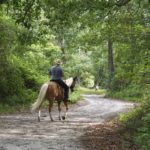When you and your horse venture out on a road with traffic, your normal trail roles are reversed. On regular trails, he does part of the thinking for you–and may even warn you, by putting up an argument, that he senses when somewhere you ask him to go is unsafe. But in traffic, his instincts don’t help him. All he can do in this alien environment is look to you for direction: On the road, it’s your job to keep yourself and your horse safe.

To ride your best in traffic, therefore, you need to think on three levels: like a rider, like the drivers you’ll meet, and–so you can anticipate his reactions to traffic and roadside “monsters”–like a horse. On top of that, the more you know about what’s ahead on a trail ride that includes a public road, the more prepared you’ll be to meet its challenges and to enjoy it. Taking the time to boost your knowledge about a planned route before you ever leave home with your horse is time well spent.
Road-Route Preview, Take One
When do you need to scope out? I preview the portion of any new trail route that runs for any distance, no matter how short, along a paved road. If a first-time ride I’m planning primarily on off-the-road and/or multi-use trails crosses paved roads, or if sections of trail are linked by a bridge or a short stretch of pavement, you better believe I preview those trail-meets-traffic areas, too. I avoid dangerous situations by discovering beforehand that, for example, a multi-use trail has a narrow pavement link (drop-off on one side, guard rail on the other) that may be fine for hikers and bicyclists but is a no-go for horses. And my scope-it-out policy applies even if my buddy for the ride says she’s familiar with the route we’ll be taking–I appreciate that extra degree of knowledge, but I won’t make the other person responsible for my safety.
How to Preview
I start by driving any road route I plan to ride that’s unfamiliar from horseback. Even if I’ve driven the road before, I need to make the trip again, this time thinking like the drivers who’ll see and react to my horse and me. I check for these main points.
Safe shoulders: level, and wide enough so my horse’s body is completely off the road and he has room to place his feet comfortably. Horses seem to like to drift onto the pavement anyway–I think they like the sound of their hooves on asphalt. If my horse feels cramped by a narrow shoulder, he’ll be even more apt to edge sideways onto the invitingly wider pavement–which is both potentially slippery and car territory. A safe shoulder also means consistently decent footing–sand, dirt, fine gravel, or trimmed grass–with no large, uneven rocks and no weeds so high they mask dangerous objects.
Lines of sight: the distance from which a horse and rider are visible to a driver, and vice versa. The higher the speed limit on a road, the longer the lines of sight need to be to let me see whether it’s safe for my horse and me to cross, and to let drivers see us in time to stop.
Safe crossing in the right places: If I see that a left curve blocks oncoming drivers’ view of a rider on the left shoulder, I check for a good right shoulder and a safe place to cross to it well before the curve. (Although for riders, as for pedestrians, traveling on the left and facing traffic is technically correct, ensuring a good line of sight is more important.) Or if I spot a roadside “monster” on the left shoulder–say, a scary mailbox that’s likely to spook my horse into traffic–I check whether the right shoulder is safe for riding and whether the line of sight in both directions allows us to cross over and avoid the bugaboo.
New subdivisions: If several dozen new homes have appeared where a back road I’m checking out once passed a large farm, I’ll expect to encounter extra cars–especially during local rush hours. And chances are that the area’s new drivers won’t be as livestock-savvy as the locals who automatically slow for horses and give them a wide berth–a change I’ll need to allow for in my planning.
Road Preview, Take Two
If my drive-by doesn’t turn up any obvious problems (or even if it does and I think there may be some alternate routes that don’t show up from a car), I give the road a closer look from a bicycle. Now I’m close enough to the environment to see such details as the texture of the pavement–is it glassy, or pebbly and grippy?–and to spot problems along my new ride that I need to plan around, such as a house with a clattery wind-driven lawn ornament.
I’m going slowly enough to spot escape routes–driveways, gaps in hedges or walls, openings in the woods–that give me a way to get off the road in a quiet, controlled manner if (for instance) a dump truck pulling a rattling construction trailer appears in the distance. And I can easily stop and get off my bike for a closer look: Especially if the escape route is a clearing in roadside woods, I look for bad footing–wet spots or holes–or debris, such as downed wires or broken glass, that could make the escape more hazardous than the road.
This second, closer look at my route is also a look for alternatives, such as a track through the woods that cuts across a bad curve, or a fallow field that could provide a shortcut past a busy corner, with the owner’s OK. Hard as it may be to knock on a door and ask a stranger for permission, this simple courtesy helps keep land accessible for riding.
Adding to the Knowns
Once you’ve determined by car and bike that the ride you’re considering is safe, add to your list of “knowns” about the route–and thereby your confidence. A few telephone calls will garner worthwhile information such as:
Trash-collection schedule. A quiet residential road can become a trail obstacle course of roadside trash-can monsters, with a garbage truck thrown in for good measure, on that one special day of the week. This may not be a problem if your horse is a savvy Road Warrior; but on a greenie, it can spoil your whole day.
School-bus schedules and routes. The size, bulk, and noise of school buses make them scary for some horses. Buses’ use of the roads may be limited to certain periods in the morning and afternoon (and, if there’s a kindergarten session, midday). The local school-superintendent’s office can tell you when buses are running and where.
Local rush hour. Although your routes will probably be on back roads, you can find yourself fighting unexpected traffic if your ride’s timing coincides with the beginning or end of the workday at a large employer in the area. You may notice factories, industrial parks, office complexes, or other workplaces during your scope-out drive; as well, check with town or county government about commercial development in the area where you’re riding. Then you can find out from the companies themselves (if any) when their employees are most likely to hit the road.
You’ve scoped out your route. You’ve added to what you know about it with a little simple research. Now, you’re ready to go out and enjoy your ride.
This article first appeared in Practical Horseman magazine.





